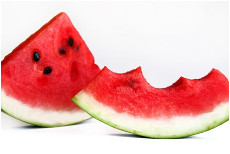Watermelon
/Watermelon has been around for at least several thousand years. Today, over four billion pounds of watermelon are produced each year in the U.S. alone. All watermelon varieties, when ripe, contain an extremely high water content of roughly 92%, as well as a variety of different phytonutrients, key vitamins and minerals, and even dietary fiber. In general, watermelon is a coveted source of lycopene and the deeper-red-flesh varieties, at peak ripeness, contain the highest concentrations. Watermelons also contain a good deal of vitamin C, beta-carotene, citrulline, cucurbitacin E, flavonoids and phenolic antioxidants. The high concentrations of Lycopene and cucurbitacin E make watermelon an excellent anti-inflammatory food. Citrulline is turned into arginine within the body, which studies suggest may help fight against obesity. When enjoyed in large amounts, watermelon's fiber content can provide additional benefits with low calorie cost. Most people eat only the juicy flesh of the watermelon, but in reality, the seeds and rind are not only edible, but packed with nutrients in their own right. Watermelon seeds provide small amounts of iron, zinc and protein when consumed regularly over time. And although watermelon seeds provide added nutritional benefits, seedless varieties still pack a nutritional punch. Seedless watermelons are products of hybridization and, up until the last decade, these varieties were relatively rare. Today, it is estimated that some 85% of all watermelons produced in the U.S. are seedless.
When purchasing watermelon of any variety, you will want it to be fully ripe as this will provide the most benefits for your health. When considering pre-cut watermelon, the most nutrient-rich option will be the one with the deepest red colored flesh without any white streaking. Choosing a whole, uncut watermelon is a bit trickier. Consider the weight of the watermelon. A fully ripened watermelon will feel heavy from high water content. You'll also want to feel the rind. You're looking for a relatively smooth rind that is slightly dulled on top (the side of the watermelon that was exposed to the elements), and that the bottom (the side that was lying on the ground) is not white or green, but more of a creamy yellow color. If you're still not sure you've found the watermelon you want, ask your grocer to core an uncut watermelon so that you can do a taste test. If you decide not to purchase it, they can still sell it sliced. Watermelon is also easy to grow in your own garden. For tips on growing watermelon, check out GardeningKnowHow.com (www.gardeningknowhow.com/edible/fruits/watermelon/growing-watermelon.htm).
Resources
Watermelon. The World's Healthiest Foods. http://www.whfoods.com/genpage.php?tname=foodspice&dbid=31
Tips for Growing Watermelon. Gardening Know How. http://www.gardeningknowhow.com/edible/fruits/watermelon/growing-watermelon.htm

